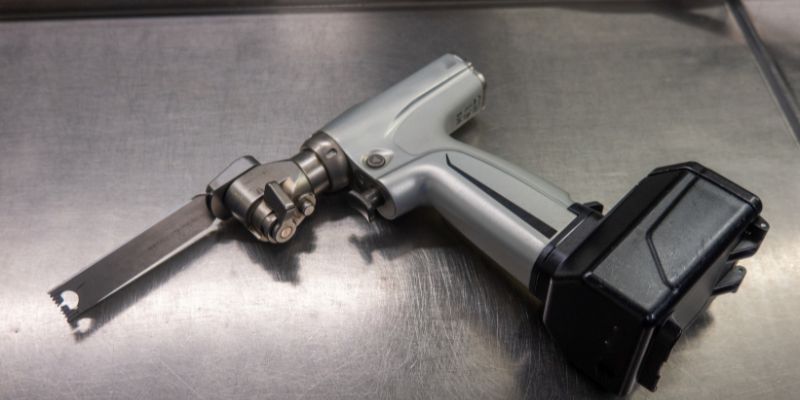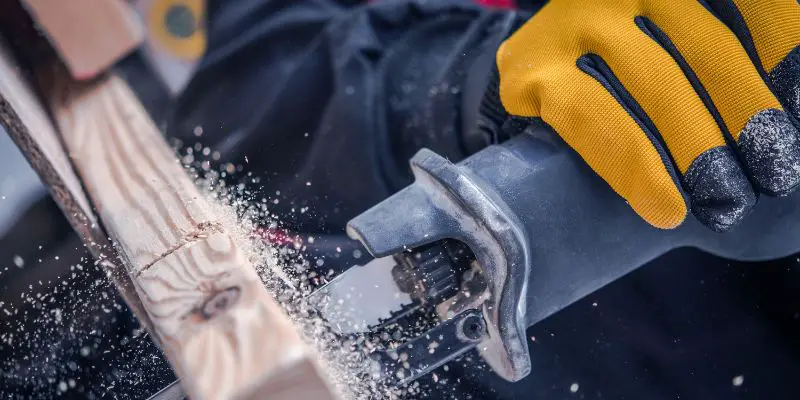The main difference between a reciprocating saw and an oscillating saw is that the reciprocating saw moves back and forth, while the oscillating saw moves in a small swinging motion. Reciprocating saws are ideal for rough cutting and demolition tasks, while oscillating saws are versatile and can handle precise cutting and detail work.
Reciprocating saws and oscillating saws are two types of power tools that are commonly used in various construction and renovation projects. Understanding their differences and capabilities is essential for choosing the right tool for the job. Reciprocating saws, also known as sawzalls, feature a straight blade that moves back and forth, creating a reciprocating motion.
This makes them great for demolitions and rough cutting tasks, such as cutting through lumber, pipes, or metal. Reciprocating saws are known for their power, versatility, and ability to cut through tough materials quickly. On the other hand, oscillating saws are designed with a small swinging motion, using a multi-purpose blade that moves side to side. This makes them ideal for precise cutting and detail work, making clean cuts in various materials like wood, metal, or plastic. Oscillating saws are popular due to their versatility, as they can also be used for sanding, scraping, and grout removal. While reciprocating saws excel in rough cutting and demolition tasks, oscillating saws are more versatile, making them better suited for precise cutting and detail work.
Reciprocating Saw
A reciprocating saw, also known as a saber saw or a recip saw, is a versatile power tool that can make your cutting tasks easier and more efficient. This handheld saw uses a push and pull motion to saw through various materials, making it ideal for demolition and remodeling projects.
Features And Benefits Of A Reciprocating Saw
A reciprocating saw comes with a range of features that make it a valuable addition to your toolbox. Here are some key features and the benefits they offer:
- Variable Speed Control: Reciprocating saws are equipped with variable speed settings, allowing you to adjust the cutting speed to suit different materials. This feature ensures precision and control, reducing the risk of damaging the workpiece.
- Quick Blade Change: One of the standout features of a reciprocating saw is its tool-less blade change system. This makes swapping blades fast and effortless, saving you time and effort during projects.
- Orbital Action: Some reciprocating saw models come with orbital action settings, which add a circular motion to the standard back-and-forth motion. This feature enhances cutting speed and can tackle tougher materials with ease.
- Versatility: Whether you’re cutting through wood, metal, plastic, or drywall, a reciprocating saw can handle the task. Its ability to make flush cuts and reach tight spaces makes it a go-to tool for many professionals.
- Portability: Reciprocating saws are portable and handheld, giving you the freedom to move around your workspace without the need for cords or additional equipment. This makes them an excellent choice for both indoor and outdoor projects.

Common Uses Of A Reciprocating Saw
The versatility of a reciprocating saw translates into a wide range of applications. Here are some common uses for this powerful tool:
- Demolition: Whether you’re tearing down walls or removing damaged structures, a reciprocating saw can make quick work of the task. It excels at cutting through nails, screws, and other fasteners, making it an essential tool for demolition projects.
- Pruning and Trimming: With the right blade attachment, a reciprocating saw can be used for pruning trees, cutting branches, and trimming shrubs. Its power and maneuverability make it an efficient tool for outdoor landscaping tasks.
- Pipe and Metal Cutting: When it comes to cutting through pipes, metal rods, or old metal structures, a reciprocating saw is a reliable choice. Its ability to cut through various metals makes it indispensable for plumbing and metalworking projects.
- Home Remodeling: From removing old tile to cutting through drywall, a reciprocating saw can assist in various home remodeling tasks. Its versatility allows you to tackle multiple materials, making it a handy tool for DIY enthusiasts and professionals alike.
Pros And Cons Of A Reciprocating Saw
Like any power tool, a reciprocating saw has its advantages and disadvantages:
| Pros | Cons |
|---|---|
| – Versatile and can cut through various materials | – May produce more vibrations compared to other saws |
| – Portable and easy to maneuver | – Can be noisy during operation |
| – Quick and tool-less blade changes | – Limited precision compared to other saws |
| – Ideal for demolition and remodeling tasks | – Requires the use of specific blades for optimal performance on different materials |
| – Can reach tight spaces and make flush cuts | – Not suited for fine woodworking projects |
Despite its drawbacks, a reciprocating saw remains an invaluable tool in many construction and renovation projects. Its versatility, power, and ability to tackle tough materials make it a must-have tool for any DIY enthusiast or professional.
Oscillating Saw
When it comes to power tools, having the right tool for the job can make all the difference. In the world of saws, two popular options are the reciprocating saw and the oscillating saw. In this blog post, we will focus on the oscillating saw, exploring its features and benefits, common uses, as well as its pros and cons.
Features And Benefits Of An Oscillating Saw
One of the key features of an oscillating saw is its versatility. Unlike other power saws that move in a back-and-forth motion, the oscillating saw blade moves in a rapid side-to-side oscillating motion. This unique cutting action allows for more precision and control, making it a valuable tool for a variety of applications.
Additionally, an oscillating saw provides you with the ability to cut through different materials such as wood, metal, plastics, and even nails or screws embedded in the material. Its interchangeable blades further enhance its versatility, allowing you to tackle various cutting tasks with ease.
Another notable benefit of an oscillating saw is its compact size and ergonomic design. It is lightweight and easy to maneuver, making it ideal for tight spaces or overhead work. Whether you’re working on a construction site, doing DIY projects at home, or engaging in delicate tasks like trimming baseboards or removing grout, an oscillating saw offers enhanced control and precision.
Common Uses Of An Oscillating Saw
An oscillating saw finds its applications in a wide range of projects, making it a staple tool for both professionals and DIY enthusiasts. Here are some common uses of an oscillating saw:
| Task | Benefits |
|---|---|
| Cutting through pipes and nails | – Oscillating saws can cut through various materials, including metal pipes and embedded nails, thanks to their powerful blades. – The small size and maneuverability of the saw make it ideal for tight spaces. |
| Trimming wood and baseboards | – The oscillating saw’s precise cutting action allows for accurate trimming of wood and baseboards without damaging the surrounding area. – The small blades can reach into corners and tight spaces, ensuring a clean and professional finish. |
| Removing grout | – The oscillating saw’s rapid back-and-forth motion with a specialized grout removal blade makes it an efficient tool for removing grout from tiles or masonry surfaces. – The controlled cutting action minimizes the risk of damaging the tiles. |
Pros And Cons Of An Oscillating Saw
As with any tool, an oscillating saw comes with its own set of advantages and disadvantages. Here are some pros and cons to consider:
Pros:
- Offers precise cutting for delicate tasks.
- Versatile and can cut through a variety of materials.
- Compact and easy to handle, especially in tight spaces.
- Interchangeable blades provide flexibility for different cutting applications.
Cons:
- May not be suitable for heavy-duty cutting tasks.
- Requires the purchase of additional blades for specific tasks.
- May produce more vibration compared to other saws.
- Not suitable for long, continuous cutting sessions due to potential overheating.
Overall, an oscillating saw is an invaluable addition to any toolbox. Its versatility and precision make it a go-to tool for a wide range of tasks, from DIY projects to professional construction work. Consider your specific needs and the nature of your projects to determine whether an oscillating saw is the right choice for you.

Reciprocating Saw Vs Oscillating Saw
When it comes to power tools, two of the most popular options among DIY enthusiasts and professionals are the Reciprocating Saw and the Oscillating Saw. Both tools have their unique features and benefits, making them suitable for various cutting tasks. In this blog post, we will compare the Reciprocating Saw and the Oscillating Saw in terms of power and cutting capabilities, versatility and range of applications, ease of use and maneuverability, safety considerations, and cost and value for money.
Power And Cutting Capabilities
Power is an essential factor to consider when choosing between a Reciprocating Saw and an Oscillating Saw. The Reciprocating Saw, also known as a recip saw or a sabre saw, is a highly powerful tool designed for heavy-duty cutting tasks. It operates with a back-and-forth motion of the blade, making it ideal for cutting through thick materials such as branches, metal pipes, and even demolition work. On the other hand, an Oscillating Saw, also known as a multi-tool, offers more precision and control. It uses a small, oscillating blade that moves side to side, allowing for precise cutting in tight spaces and delicate materials like wood trim, drywall, and plastic.
Versatility And Range Of Applications
When it comes to versatility, the Oscillating Saw takes the lead. It is a jack-of-all-trades tool, capable of performing various tasks such as cutting, sanding, scraping, and grout removal. With the right blade attachment, an Oscillating Saw can tackle almost any project, from home renovations to crafts and repairs. On the other hand, the Reciprocating Saw, although less versatile, excels in specific applications like demolition, pruning, and cutting through heavy materials. Its power and aggressive cutting motion make it perfect for heavy-duty tasks that require speed and strength.
Ease Of Use And Maneuverability
Both the Reciprocating Saw and the Oscillating Saw are relatively easy to use, but they differ in terms of maneuverability. The Reciprocating Saw has a larger and bulkier design, which can make it challenging to maneuver in tight spaces or overhead positions. However, it compensates with its brute power and efficiency. On the other hand, the Oscillating Saw is compact and lightweight, allowing for better control, especially in confined areas. Its slim profile and versatility make it an excellent choice for precision cutting and handling.
Safety Considerations
When working with any power tool, safety should always be a top priority. Both the Reciprocating Saw and the Oscillating Saw come with their own safety considerations. The Reciprocating Saw’s aggressive cutting action requires caution, as it can easily kick back or cause the blade to bind. It is important to wear protective gloves, and eyewear, and ensure a firm grip on the tool. On the other hand, the Oscillating Saw’s small and precise blade poses a lower risk of kickback or blade-related injuries. However, proper safety precautions like wearing protective gear and using the right blade for the task at hand should still be observed.
Cost And Value For Money
When it comes to cost and value for money, the choice between a Reciprocating Saw and an Oscillating Saw largely depends on the specific needs of the user. Reciprocating Saws are generally more affordable, with a wide range of options available to fit various budgets. They offer excellent value for money, especially if you require the power and versatility for heavy-duty tasks. Oscillating Saws, on the other hand, tend to be more expensive due to their versatility and precision cutting capabilities. They are an investment worth considering if you require a tool that can handle multiple applications with ease.
Frequently Asked Questions For Reciprocating Saw Vs Oscillating Saw
When Should You Not Use A Reciprocating Saw?
Avoid using a reciprocating saw when working with delicate materials like veneer or trim, as it may cause damage. Similarly, avoid using it for precision cuts or in situations where control is important. Additionally, refrain from using it for overhead work or in confined spaces where maneuverability is limited.
What Is The Difference Between Reciprocating And Oscillating Saw Surgery?
Reciprocating saw surgery uses back-and-forth motion while oscillating saw surgery moves side-to-side.
What Is A Reciprocating Saw Best Suited For?
A reciprocating saw is best suited for cutting through materials like wood, metal, and plastic. It’s ideal for demolition work, pruning tree branches, and making rough cuts in construction projects. With its back-and-forth motion, it provides versatility and power for various applications.
What Is The Difference Between A Saw And A Reciprocating Saw?
A saw and a reciprocating saw are different tools. A saw is a general term for cutting tools with a blade, while a reciprocating saw is a type of saw that has a back-and-forth cutting motion. Reciprocating saws are commonly used for demolition work and cutting in tight spaces.
Conclusion
To conclude, both reciprocating saws and oscillating saws have their own unique benefits and applications. The reciprocating saw is ideal for demolition work and rough cuts, while the oscillating saw excels in precision tasks and delicate cuts. Ultimately, the choice between the two depends on the specific project requirements and personal preferences.
By understanding the differences and strengths of each tool, you can make an informed decision and achieve the best results for your cutting needs.



One thought on “Reciprocating Saw Vs Oscillating Saw: The Ultimate Power Showdown”